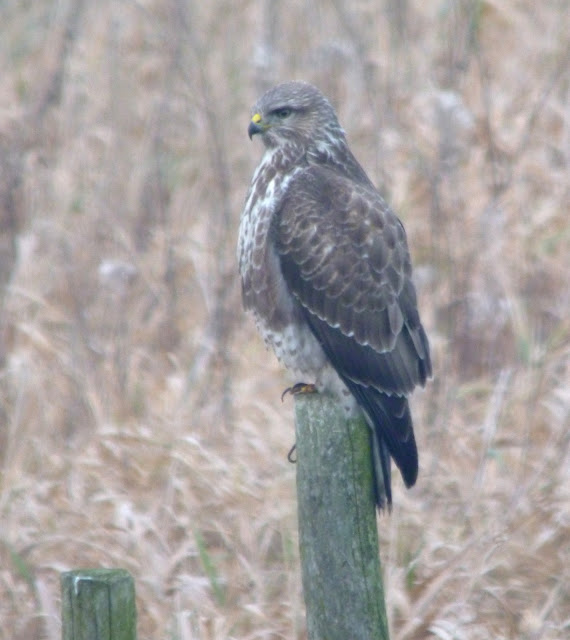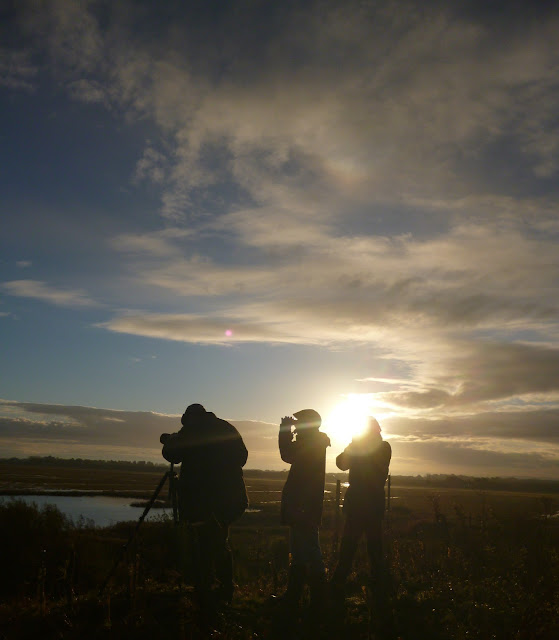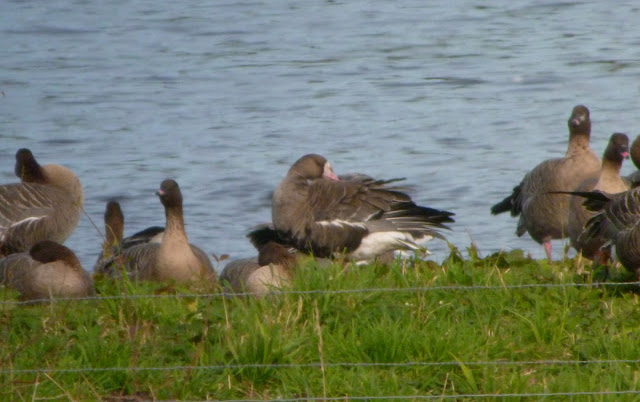Coordinated pink-footed goose count this morning and I met with Sean and Kim Ashton at 7a.m. at Marshside sandworks to count the Ribble roost. The slight elevation on the footprint of the old Mt Baker allows viewing up river past the mouth of the Crossens channel as far as the edge of the Ribble National Nature Reserve. The exact site of goose roost varies and it can be spread from the end of the haul road all the way east along the mudflats towards Lytham and beyond. It's a big job, hence three of us tackling it. Over an hour we counted the grand total of 23,774; a marvellous, life affirming sight and sound in the early morning sunshine.
Pink-feet heading inland over the sandworks this morning
Sunrise over Marshside with skeins of Pink-feet heading inland to feed
The goose count was finished at 8a.m. and Steve Sweetnam picked me up and we headed to Euston Street in Preston where we immediately connected with 67 Waxwings perched in treetops trying to avoid being harassed by an obviously irritated Mistle Thrush.
Some of the Preston Waxwings this morning
While watching the Preston Waxwings Frank Whitney, a fellow Burscough birder, called me to say he'd just found a group of Waxwings while out dog-wailking near his house in Burscough. Steve and I thought it rude not to go and have a look at them and we duly arrived and saw 20 of these amazing little birds with Frank and Phil Boardman. By this time Steve and I were ready for a big breakfast and TC's in Mere Brow duly obliged. Post breakfast we considered our options and headed to the seawall at Banks from where we scannned the vast expanse of saltmarsh that is the Ribble NNR. The NNR rarely disappoints and we quickly saw a Great White Egret, 18 Little Egrets and a Spoonbill. The vast flocks of Wigeon, Teal, Lapwing and Golden Plover were constantly flushing and on closer inspection a total of three Peregrines were seen harassing flocks. All of Peregrines were dopey juvs, one of them had a speculative strike at a Shelduck.
Steve was keen for a mooch across Churchtown Moss and we drove across in the direction of Bescar Lane. c.40 Fieldfares near four lane ends were nice to see and three Buzzards were drifting around there. We checked a couple of Pheasant feeders in one of the copses for Brambling, none were seen but a pair of calling Nuthatches is still noteworthy on that part of the moss. Heading towards Bescar Lane huge three huge flocks of Woodpigeons could be seen, I estimated 13000. No Crane out there but at least another four Buzzards, a Kestrel and a Sparrowhawk.
Some of the Woodpigeons near Bescar Lane today
Our last journey was searching for Harriers across the mosses between Halsall and Ainsdale. We didn't see any, but we did see big flocks of my favourite bird; you already know, don't you?
Pink-feet feeding close to the housing estate at Carr Moss near Ainsdale
We choose a flock adjacent to the housing estate off Carr Lane in Ainsdale to look through and it was worthwhile, despite being mithered by some of the local nutters. 6200 geese were present, one a Barnacle Goose, one a Greylag Goose and best of all one was an adult Greenland white-fronted Goose (my first this winter). I found three neck-collared birds; FIU, PBH and PVJ. Another huge flock (c.6000) of Woodpigeons could be seen over the local copses and in the distance another field full of Pink-feet could be seen. Alas, we ran out of time but a good session in the field. Can't beat it.



















































